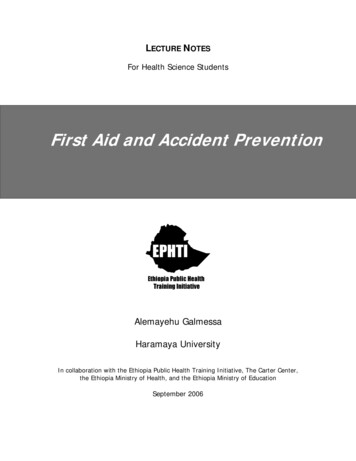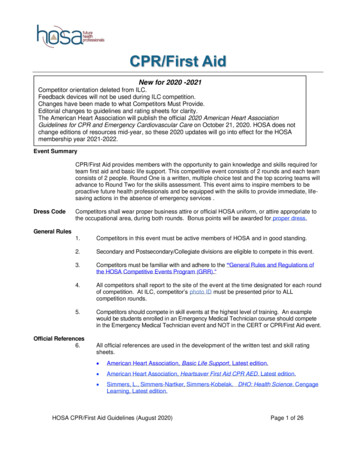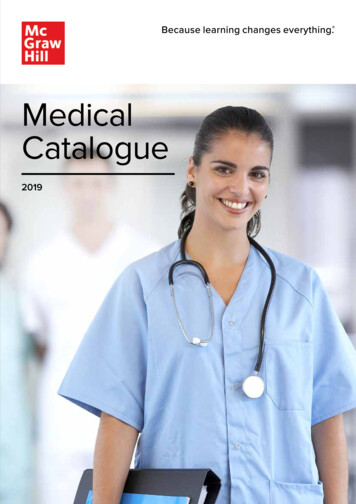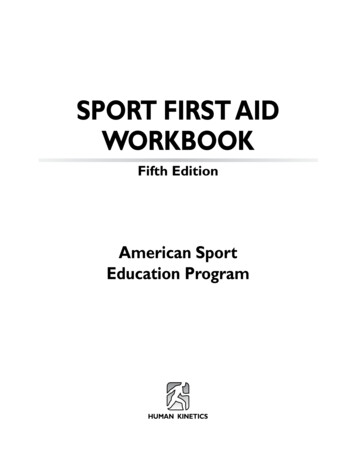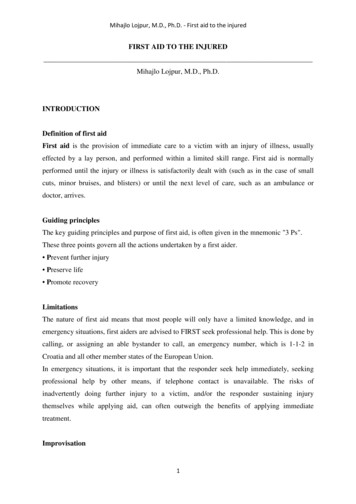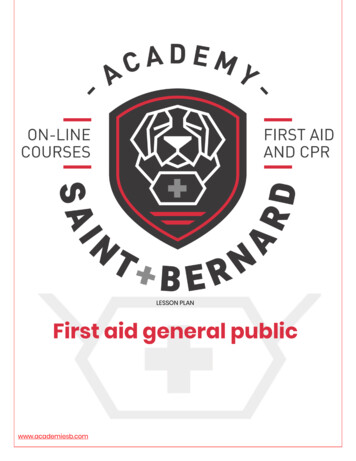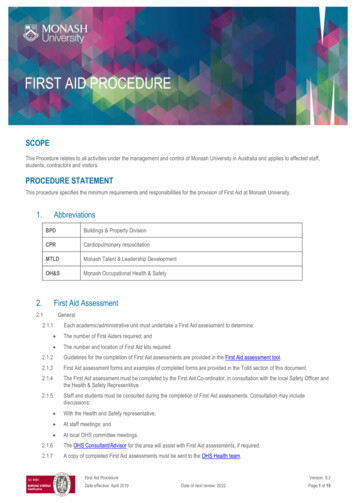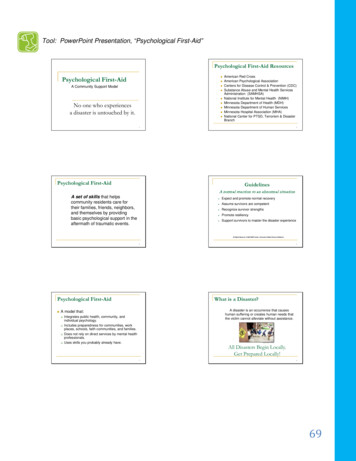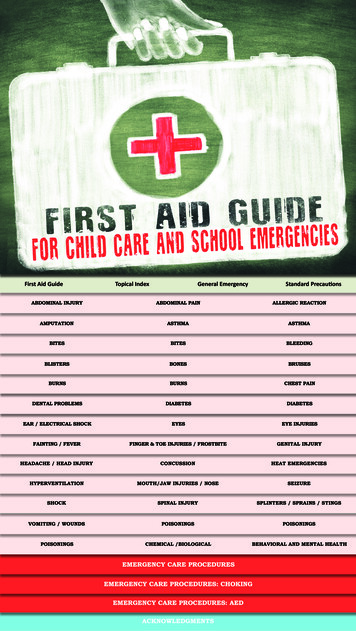
Transcription
First Aid GuideTopical IndexGeneral EmergencyStandard PrecautionsABDOMINAL INJURYABDOMINAL PAINALLERGIC ISTERSBONESBRUISESBURNSBURNSCHEST PAINDENTAL PROBLEMSDIABETESDIABETESEAR / ELECTRICAL SHOCKEYESEYE INJURIESFAINTING / FEVERFINGER & TOE INJURIES / FROSTBITEGENITAL INJURYHEADACHE / HEAD INJURYCONCUSSIONHEAT EMERGENCIESHYPERVENTILATIONMOUTH/JAW INJURIES / NOSESEIZURESHOCKSPINAL INJURYSPLINTERS / SPRAINS / STINGSVOMITING / WOUNDSPOISONINGSPOISONINGSPOISONINGSCHEMICAL /BIOLOGICALBEHAVIORAL AND MENTAL HEALTHEMERGENCY CARE PROCEDURESEMERGENCY CARE PROCEDURES: CHOKINGEMERGENCY CARE PROCEDURES: AEDACKNOWLEDGMENTS
FIRST AID GUIDE FOR CHILD CAREAND SCHOOL EMERGENCIESThis flipchart is a quick reference guide for administering emergency care to an injured or ill individual. It containspractical, step-by-step instructions that describe what to do when caring for an injured or ill person. It replacesa previous edition published in 2003.Who Should Use this FlipchartThis flipchart is designed for use by teachers, school nurses, clinic aides, early care and education and other staffmembers responsible for the health and safety of students and others in a school or community setting. Do notuse treatment methods beyond your skill level or your scope of practice. When in doubt, call 911 or your localemergency services.How to Use This FlipchartThis flipchart should be posted in a place that is easily accessible to all staff members. It is recommended thatall staff become familiar with the contents of this flipchart prior to the necessity for handling an emergencysituation.This flipchart serves as a guide to help the user handle emergency situations.
SECTIONDESCRIPTIONTOPICAL INDEXALPHABETICAL LISTING OF ALL TOPICS CONTAINED IN THIS FLIPCHART.GENERAL EMERGENCY GUIDELINESPROVIDES GENERAL GUIDANCE AND INFORMATION ON THE ADMINISTRATIONOF EMERGENCY ASSISTANCE TO INDIVIDUALS WHO ARE ILL OR INJUREDPRIOR TO THE ARRIVAL OF EMERGENCY MEDICAL PERSONNEL.STANDARD PRECAUTIONSPROVIDES AN OVERVIEW OF HANDLING BLOODAND BODY FLUIDS IN THE SCHOOL SETTING.FIRST AID PROCEDURESDESCRIBES SPECIFIC PROCEDURESFOR TREATING AN ILL OR INJURED INDIVIDUALIN ALPHABETICAL ORDER.POISONINGSGIVES DETAILED INSTRUCTIONS FOR HANDLING AN INDIVIDUALWHO HAS INGESTED OR, IN SOME WAY, COME INTO CONTACTWITH A POISON OR OTHER HAZARDOUS SUBSTANCE.CHEMICAL, BIOLOGICAL,RADIOLOGIC, NUCLEAR, EXPLOSIVEEVENTS OR BOMB THREATGIVES INSTRUCTIONS FOR WHOM TO CONTACT IN THESE EMERGENCIES.BEHAVIORAL AND MENTALHEALTH EMERGENCIESPSYCHOLOGICAL FIRST AID. GIVES INSTRUCTIONSFOR MANAGING SUICIDE RISK AND ACTIVE SHOOTER SITUATIONS.EMERGENCY CARE PROCEDURESDESCRIBES PROCEDURES FOR HANDLING EMERGENCY AND LIFE-THREATENING CRISIS,MEDICAL SITUATIONS INCLUDING CPR, CHOKING, AND AED USE.
TOPICAL INDEXGENERAL EMERGENCY GUIDELINESSTANDARD PRECAUTIONSFIRST AID PROCEDURESABDOMINAL INJURYGeneral Wounds / Protruding WoundsABDOMINAL PAINNon Severe / Stomach Ache Severe /With or Without VomitingALLERGIC REACTIONAnaphylaxisEpinephrine injectors (EpiPen )Hives (Rash) / Itching / mal / Human / Spider / TickBLEEDINGInternalSevere Bleeding from a WoundBLISTERS BROKENBROKEN BONESDislocation / Closed Fracture / Open FractureCastsCHEST PAINGeneralCardiac ArrestDENTAL PROBLEMSBaby Teeth / Tooth LossBroken Braces and Wires / Broken or DisplacedTooth / Knocked Out Permanent ToothToothacheWedged Objects between TeethHYPERVENTILATIONMOUTH / JAW INJURIES / NOSE BLEEDSNose Bleeds / Foreign ObjectsSEIZURESHOCKSPINAL INJURYSPLINTERSDIABETESHyperglycemia / Hypoglycemia (Conscious)Hypoglycemia (Unconscious)SPRAINS / STRAINSEARBug / Insect in Ear / Earache / Foreign ObjectVOMITINGELECTRICAL SHOCKWOUNDSCuts or Superficial Abrasion / Deep or ExtensiveLaceration / PunctureEYESChemical Burns / Discharge / Foreign ObjectEYE INJURIESBruises / Blows / Penetrating InjuryFAINTINGSTINGS (INSECT)POISONINGSIngested or Swallowed / Inhalation of Gas Vapors /Ocular (Eye) Exposure / Skin ExposureCHEMICAL, BIOLOGICAL, RADIOLOGIC, NUCLEAR,EXPLOSIVE EVENTS OR BOMB THREATFEVERFINGER and TOE INJURIESGeneral / Torn Fingernail or ToenailBEHAVIORAL AND MENTAL HEALTHEMERGENCIESFROSTBITERisk of SuicideActive ShooterGENITAL INJURYScrotal or Penile / VaginalBRUISESHEADACHEBURNSChemical / ElectricalFirst Degree Thermal / Heat Second DegreeThermal / Heat Third Degree Thermal / HeatHEAD INJURYConcussionHEAT EMERGENCIESHeat Cramps / Heat Exhaustion / Heat StrokeEMERGENCY CARE PROCEDURESCardiopulmonary Resuscitation (CPR)Adult, Children and InfantsChokingResponsive Child or Adult / Unresponsive Child orAdult / Responsive Infant / Unresponsive InfantAutomatic External Defibrillation (AED)
GENERAL EMERGENCY GUIDELINES
STANDARD PRECAUTIONS FOR HANDLINGBLOOD AND BODY FLUIDS IN SCHOOLPotentially Infectious Body FluidsBloodFecesOrgan TissueUrineVomitAmniotic FluidSalivaCerebrospinal FluidSemenInfections Transmitted Through Blood & Body FluidsHIVHepatitis AHepatitis BHepatitis CStaph Infections, including Methicillin ResistantStaphylococcus Aureus (MRSA)Strep InfectionsGastroenteritisSyphilisMeaslesUrinary Tract InfectionsSalmonellaTuberculosisChicken PoxEbolaOther blood infectionsPneumoniaMalariaHerpesNorovirus
STANDARD PRECAUTIONS FORHANDLING BLOOD AND BODY FLUIDSIN SCHOOL Avoid direct contact with body fluids. Caregivers who anticipate assisting in first aid when body fluids are present (e.g.,cleaning cuts and scrapes, treating a bloody nose) should usedisposable gloves.Caregivers should use protective eyewear and masks in certainsituations. If unanticipated skin contact occurs, hands and all otheraffected skin should be washed with soap and running wateras soon as possible. The local procedures for blood and bodyfluid exposure should be followed. qLather with soap by rubbing hands together Include back of hands, in betweenfingers and under nailsqDiligent and proper hand washing, the use of barriers (e.g.,gloves), appropriate disposal of waste products and needles,and proper care of spills are essential techniques of infectioncontrol.If it is necessary to perform CPR, a one-way mask or otherinfection control barrier should be used. CPR should not bedelayed while such a device is located.1.Spills of blood and body fluids should be cleaned up immediately with an approved disinfectant cleaner. Refer to localitypolicy or use 1:10 ratio of a bleach/water solution.2.Mix 1 part household 5.25% bleach in 10 parts of water (1/4cup/1 gallon) OR if using a concentrated bleach of 8.25 % mix3 tbsp/gallon. Replace solution daily.3.Wear gloves.4.Mop up spill with absorbent material.5.Wash the area well, using an approved disinfectant cleaner ora 1:10 bleach/water solution.6.Dispose of gloves, soiled towels, and other waste in sealedplastic bags and place in garbage.qRinse hands under clean running waterqDry hands using a clean towel, blow dry or air dryGLOVES1. Gloves must be worn when direct care may involve contactwith any type of body fluid. Refer to CDC Personal ProtectiveEquipment Poster for instruction on donning and removinggloves, Disposable, single-use, waterproof gloves (e.g., latex or vinyl)should be used. (Vinyl gloves should be used with individualswho have a latex allergy or a high potential for developing alatex allergy, e.g., individuals with spina bifida.)3.Discard gloves in the appropriate container after each use.4.Hands should be washed immediately after glove removal.DISPOSAL OF INFECTIOUS WASTECLEAN-UP: Routine environmental clean-up1.When surfaces become contaminated with blood or bodyfluids, use the procedures outlined above.2.Regular cleaning of non-contaminated surfaces (e.g., toiletseats, tabletops) can be done with standard cleaning solutionsor the 1:10 bleach/water solution described above. Regularcleaning of obvious soil is more effective than extraordinaryattempts to disinfect or sterilize surfaces.3.Brooms and dustpans must be rinsed with disinfectant.Mops must be soaked in disinfectant, washed, and thoroughly rinsed. The disinfectant solution should be disposed ofpromptly down the drain.1. All used or contaminated supplies (e.g., gloves and otherbarriers, sanitary napkins, bandages) except syringes, needles,and other sharp implements should be placed into a plasticbag and sealed. This bag can be thrown into the garbage out ofreach of children or animals.2.Needles, syringes, and other sharp objects should be placedimmediately after use in a puncture- proof container that is leakproof on the bottom and sides. To reduce the risk of a cut oraccidental puncture by a needle, NEEDLES SHOULD NOT BERECAPPED, BENT, OR REMOVED FROM THE SYRINGE BEFOREDISPOSAL.3.Once the container is full, it should be sealed,bagged, and keptout of the reach of children or animals until it can be disposedof properly.Body waste (e.g., urine, vomitus, feces) should be disposed ofin the toilet. If body fluids (e.g., urine, vomitus) are spilled, thebody fluids should be covered with an absorbent sanitarymaterial, gently swept up, and discarded in plastic bags.CLEAN-UP: Spills of blood and body fluidsScrub your hands for at least 20 secondsUse Standard Precautions and infection control techniques inall situations that may present the hazard of infection.Precautions should be observed and appropriate protectionused when caring for bleeding injuries or handling other bodyfluids in emergency situations. Body fluids include blood,drainage from cuts, scabs, skin lesions, urine, feces, vomit, nasal discharge, and saliva. The body fluids of all persons shouldbe considered to be potentially hazardous.4.Wet your hands with clean drinking waterAnticipate potential contact with infectious materials in routine and emergency situations. Following standard precautionsis the most important step in preventing exposure to andtransmission of infections. HAND WASHING PROCEDUREPLEASE REFER TO THE OCCUPATIONAL SAFETY AND HEALTH ADMINISTRATION (OSHA) FINAL BLOODBORNE PATHOGENS STANDARDS FOR THE MOST RECENT REQUIREMENTS ATHTTPS://WWW.OSHA.GOV
FIRST AID PROCEDURESABDOMINAL INJURYTREATMENTGENERAL WOUNDS1.2.3.4.5.Determine cause of injury. Ensure safety of environment.Call 911.Wear gloves. Use Standard Precautions (see Standard Precautions).Carefully position individual on back.If movement of the legs does not cause pain, place a pillowunder knees to help relax the abdominal muscles.6. If movement of the legs causes pain, leave individual lying flat.7. Control bleeding with a bulky dressing. If ineffective, or ifbleeding is severe, apply QuickClot directly to bleedingsite.8. Do not give food or drink.9. Do not give medication.10. Call parent/guardian.PROTRUDING WOUNDSABDOMINAL PAIN (STOMACH ACHE)NON SEVERE / STOMACH ACHETREATMENT1.2.3.Take temperature orally, ensuring no food or beverageshave been consumed for at least 15 minutes.Have individual rest 15-30 minutes.If oral temperature is greater than 100.3 F (38 C) and/or pain intensifies, call parent/guardian and recommendcontact with healthcare provider via a telephone call or anoffice visit.SEVERE / WITH OR WITHOUT VOMITINGTREATMENT1.2.3.4.5.Call 911.Do not give anything to eat or drink.Do not give medication.Take temperature.Call parent/guardian.DEFINITION: A protruding abdominal wound is an injuryto the abdomen causing internal organs to be exposed orprotrude through the wound.TREATMENT1.2.3.4.5.Determine cause of injury. Ensure safe environment.Call 911.Wear gloves. Use Standard Precautions (see Standard Precautions).Carefully position individual on back.If movement of the legs does not cause pain, place a pillowunder knees to help relax the abdominal muscles.6. If movement of the legs causes pain, leave individual lying flat.7. Do not apply any pressure to the protruding organs.8. Do not attempt to push protruding organs back into the abdomen.9. Remove any clothing from around wound.10. Cover wound with clean cloth (preferably sterile).11. If there is a delay in medical assistance:12.13.14.15.ANAPHYLAXISALLERGIC REACTIONDEFINITION: An allergic reaction is an exaggerated immuneresponse by the body to a foreign material. Anaphylaxisis a severe and sudden immune reaction that can lead toanaphylactic shock, which is potentially life threatening.CAUSES up or perfumesSIGNS AND SYMPTOMS Apprehension/NervousnessRash (particularly on face)HivesItchingSwelling of affected areas (particularly on face, tongue, lipsand neck)Breathing difficulty-wheezing, coughing, gurgling, stridor,grunting or high-pitched soundsSkin is flushed and dry or pale, cool, and clammyIncreased heart rate, weak pulseTREATMENT1. Loosely drape sterile dressings or a clean cloth overthe wound. Use sterile saline to moisten the dressings. Hold dressing in place with bulky bandage.If individual is known to have allergies, consult the writtenemergency action plan on file and proceed with healthcare provider’s instructions, such as administration of auto-injectableepinephrine (for example, Adrenaclick , Auvi-Q or Epi Pen ).(See Epinephrine)2.3.Treat for Shock (see Shock).Do not give food or drink.Do not give medication.Call parent/guardian.4.5.Direct someone to call 911.Check individual’s pulse and respiration. Be alert forbreathing and pulse being slower or faster than usual. Ifnecessary, certified personnel start CPR (see CPR and Shock).Provide oxygen if available.Call parent/guardian.See next pageABDOMINAL INJURYABDOMINAL PAINALLERGIC REACTIONq
ALLERGIC REACTIONcontinuedALLERGIC REACTIONHIVES (RASH) / ITCHINGDEFINITION: Hives are eruptions of the skin caused by contact withor ingestion of an allergic substance or food. Hives appear as raisedblotches on the skin, pale in the middle, with reddened border, oftenaccompanied by itching. Hives involving mouth, eyelids and tongue arepotentially life-threatening.1.If hives and itching involve eyelids, lips, mouth, or tongue, call911.2.If individual is known to have allergies, consult the written emergency action plan on file and proceed with healthcare provider’sinstructions, such as the administration of an antihistamine (forexample, Benadryl) or auto-injectable epinephrine (for example,Adrenaclick , Auvi-Q or Epi Pen ). See Epinephrine.Apply cold compress.Give reassurance.If individual is too uncomfortable to do school work, send home.Call parent/guardian.DOSAGEDEFINITION: Wheezing is an abnormally high-pitched noiseresulting from a partially obstructed airway. Check forEmergency Care Plan and initiate treatment as directed.Airway obstruction is potentially life threatening.2.3.4.5.6.If breathing difficulty worsens (skin color changes, wheezing, retraction of nose, cheeks or chest), prolongs, or occurs with hives and/orswelling, call 911.Place individual in comfortable position, usually sitting.Provide oxygen if available.If individual is known to have Asthma, (see Asthma section). If anindividual has a prescription for an inhaled bronchodilator (forexample, Albuterol), prepare to assist individual to administerprescribed medication.If breathing worsens or individual stops responding, certified personnel start CPR (see CPR).Call parent/guardian.SWELLINGEpinephrineNOTE: An allergic reaction that causes swelling is potentially life threatening.DEFINITION: Epinephrine (or adrenaline) is a non-selective alphaand beta-adrenergic receptor agonist indicated in the emergencymanagement of allergic reactions and anaphylaxis. It works byconstricting blood vessels and dilating airways. Examples of autoinjectable epinephrine include Adrenaclick , Auvi-Q , or EpiPen .Specific instructions for their use are available online.TREATMENT1.If there is face, mouth,and neck swelling, call 911.2.If individual is known to have allergies, consult the written emergency action plan on file and proceed with healthcare provider’sInstructions, such as the administration of an antihistamine (forexample, Benadryl) or auto-injectable epinephrine (for example,Adrenaclick , Auvi-Q or Epi Pen ). (See Epinephrine).3.4.5.Apply cold compress.Give reassurance.Call parent/guardian.DOSAGE3. Remove the safety cap and grasp the centerof the auto-injector.qq5. Push the device firmly against thigh (through clothes ifnecessary) and hold in place until medication is injected (atleast *10 seconds). Remove from individual and dispose ofin biohazard /sharps container.*Note: Check manufacturer instructions for time ofdelivery of medication.SIDE EFFECTSIncreased Heart RatePallorDizzinessChest PainHeadacheNauseaVomitingExcitability & AnxietyTremorAFTERCAREOnce the auto-injectable epinephrine device is used, continue to closelymonitor the individual’s heart rate and breathing patternTell the first responder the time the auto-injectableepinephrine device was usedThe individual MUST be seen by a healthcare provider immediately onceauto-injectable epinephrine has been administered0.15 mg Epinephrine auto-injector IM33 LBS - 66 LBS (15KG- 30KG)0.30 mg Epinephrine auto-injector IM 66 LBS ( 30 KG)1. Verify individual is having an allergic or anaphylacticreaction (see Signs and Symptoms above).q2. Obtain individual’s prescribed auto-injectableepinephrine. Ensure the medication is prescribed toaffected individual, is correct dosage, is not discoloredand has not expired.qALLERGIC REACTIONcontinued4. Place the tip of the device against the individual’souter thigh midway between the waist and knee.TREATMENT1.TREATMENT3.4.5.6.WHEEZINGIf necessary, certified personnel should be prepared to initiate CPR
AMPUTATIONDEFINITION: Amputation is the severing (all or part) of a limb ordigit of the body.TREATMENT1.2.3.4.5.6.7.Call 911 immediately.Wear gloves. Use Standard Precautions (see Standard Precautions).Control bleeding by placing a clean dressing (preferably sterile) overthe wound and apply pressure on a nearby artery. If the individualcontinues to bleed, use a tourniquet if possible (see instructionsbelow). And if available, apply QuickClot directly to bleeding site.Never complete the amputation.Treat for Shock (see Shock).If complete amputation: Place direct pressure on wound site. Place indirect pressure on nearby arteries. Locate severed body part. Do not wash severed part. Wrap part in clean (preferably sterile) dressing. Place part in plastic airtight bag and lay bag in pan of waterkept cool with ice packs. Do not put part directly on ice. Give part to EMS personnel.Call parent/guardian.4.Place tourniquet around extremity and tighten to the pointthat bleeding is controlled. Do not tighten beyond that point.5.Once a tourniquet has been applied, do not remove or loosenit unless ordered by a healthcare provider. This can dislodgeclots and cause further bleeding.6.Leave the tourniquet open to view and frequently assessthe site. Attach a notation to the individual to alert firstresponders that a tourniquet has been applied and indicatethe time of application.ASTHMANOTE: Asthma is a lung disease that causes repeated episodes ofbreathing problems. Symptoms of asthma can be mild, severe, orfatal. Asthma is potentially life threatening.COMMON SIGNS AND SYMPTOMS Difficulty breathingWheezing (high-pitched, whistling sound)CoughingTightness in chestShortness of breathBlue lips or nail bedsDEFINITION: A tourniquet is a device that closes off all blood flowto and from an extremity to control severe bleeding that cannotbe controlled by direct pressure to the artery. Rubber or latextourniquets may be available in first aid kits.NOTE: Tourniquets can be improvised by using belts, bloodpressure cuffs, articles of clothing or other mechanical devices inan emergency. They should be at least 2-4 inches wide and severallayers thick. If available, QuickClot may be used in conjunctionwith tourniquet.PROCEDURE1.Assess the site of severe bleeding or amputation.2.If another person is present, have them apply firm anddirect pressure above the wound to slow bleeding while thetourniquet is applied.3.Select a site no farther than 2 inches from the wound. If thewound is on a joint, apply the tourniquet above the joint.AMPUTATIONDEFINITION: Most individuals with asthma have a prescriptionfor a metered-dose inhaler (MDI) with an inhaled bronchodilatormedication such as Albuterol. This medicine works by selectivelywidening the individual’s small and large airway passages, so theycan breathe oxygen more easily. When an individual with asthmais having an asthma attack as described above, they may needassistance or coaching in properly using their inhaled medication.BEFORE USING ANY MEDICATION, ENSURE THE PRESCRIPTION IS FORTHE RIGHT INDIVIDUAL AND IS NOT EXPIRED1. Shake the inhaler vigorously. Ensure it is atroom temperature or warmerq2. Make sure the individual is alert enough to use theinhaler properly. Use a spacer device(Aerochamber) if availableq3. Make sure the individual first exhales deeplyTREATMENTTOURNIQUETINHALER ADMINISTRATIONqSEVERE SIGNS AND SYMPTOMSDifficulty breathing, irregular high pitched wheezingMinimal air movementRespiratory Rate 12 or 30 breaths per minuteDecreased level of consciousnessBluish lips or nail beds4. Have the individual put their lips around the opening andpress the inhaler to activate the spray as they inhale deeplyq5. Have the individual hold their breath 10 secondsand than exhaleqRefer to written emergency asthma action planIf applicable, assist individual in adminsteringprescribed inhaled bronchodilator medicationqCALL 911 AND PARENT / GUARDIANASTHMAASTHMA
BITESNOTE: For all bites, if there is any history of allergic reaction or ifindividual experiences signs and symptoms of an allergic reaction(see Allergic Reaction), call 911.ANIMAL BITE7.8.Wear gloves. Use Standard Precautions (see Standard Precautions).Remove rings and bracelets from bitten extremity.Cleanse wound thoroughly with soap and water for 5 minutes.Cover wound with clean bandage (preferably sterile).Determine individual’s tetanus immunization status.If injury not severe, call parent/guardian and recommendcontact with healthcare provider via a telephone call or an office visit.Call Animal Control.Report all animal bites to the local health department.HUMAN BITEWear gloves. Use Standard Precautions (see Standard Precautions).Remove rings and bracelets from bitten extremity.Cleanse wound thoroughly with soap and water for 5 minutes.Cover wound with clean bandage (preferably sterile).Determine individual’s tetanus immunization status.Assess Hepatitis B vaccination status of involved individual.Call parent/guardian and recommend contact with healthcareprovider.SPIDER: BLACK WIDOW and/orBROWN RECLUSE BITENOTE: Bites from black widow spiders and brown recluse spidersare potentially life threatening.SIGNS AND SYMPTOMS – Black Widow Red lesion at bite siteLesion blisters and may become painful ulcerationFeverNauseaBody rash1.2.3.4.5.6.7.8.Wear gloves use Use Standard Precautions (see Standard Precautions).Lower affected part below the level of the heart.Remove rings and bracelets from bitten extremity.Cleanse area with soap and water.Apply cold compresses.Keep bitten extremity immobilized.If signs and symptoms of allergic reaction occur (see Allergic Reaction),call 911.Call parent/guardian and recommend contact with healthcareprovider via telephone call or office visit.TICK BITETREATMENT1.2.3.4.5.6.7. TREATMENTTREATMENT1.2.3.4.5.6.SIGNS AND SYMPTOMS – Brown ReclusePain at site of bitePain, muscle spasm, and paralysis at distant siteNausea and vomitingAbdominal crampsChest tightnessDifficulty breathingDizzinessSweatingSigns of shock (see Shock)BITESTREATMENT1.Wear gloves. Use Standard Precautions (see Standard Precautions).2.Using tweezers, remove tick as follows: 3.Grasp tick as close to the skin as possible.Gently, but firmly pull tick straight out.Avoid any twisting or jerking motion that may break off themouth parts in the skin.Do not remove tick using nail polish, petroleum jelly, alcohol,or a hot match.4.After the tick has been removed, cleanse area thoroughly withsoap and water.5.If signs and symptoms of allergic reaction occur (see AllergicReaction), call 911.6.Call parent/guardian and recommend contact with healthcareprovider via telephone call or office visit.BITESINTERNALBLEEDINGNOTE: Internal bleeding is potentially life threatening.SIGNS AND SYMPTOMS Bruising, swelling, or pain over a vital organPainful, swelling of the affected areaTender, rigid, distended abdomenSigns of shock (see Shock)TREATMENT1.2.3.4.5.6.7.8.Determine cause of injury.Call 911.Wear gloves. Use Standard Precautions (see Standard Precautions).Maintain open airway. If necessary, certified personnel startCPR (see CPR).Monitor for signs and symptoms of shock (see Shock).If vomiting, lay individual on side.Keep individual warm, comfortable, and calm.Call parent/guardian.SEVERE BLEEDING FROM A WOUNDTREATMENT1.2.3.Determine cause of injury.Call 911.Wear gloves, mask, and protective eyewear. Use StandardPrecautions (see Standard Precautions).4. Control bleeding by placing a clean covering (preferablysterile) over wound and applying direct pressure.5. If injury does not appear to involve broken bone, elevateinjured area above the level of the heart.6. If necessary, add more dressings. Do not remove previousdressing. Secure dressing in place.7. In case of amputation, (see Amputation).8. If bleeding cannot be controlled with firm and direct pressureto wound, see instructions on applying a tourniquet (seeTourniquet).9. Treat for shock (see Shock).10. If necessary, certified personnel should start CPR (see CPR).11. Call parent/guardian.BLEEDING
BLISTERSTREATMENT1.2.3.4.5.Wear gloves. Use Standard Precautions (see Standard Precautions).Cleanse area with soap and water. Avoid breaking blister.Apply a dry bandage.If blister is broken, wash with soap and water and apply drybandage.If blistered area is red, swollen, and/or painful, call parent/guardian and recommend contact with health care provider bya telephone call or office visit.BROKEN BONES5.6.7.8.9.Immobilize extremity by supporting joints on either side ofinjury with pillows, blankets, broomstick, uninjured limb, etc.,to reduce pain.Assess and treat for shock (see Shock).If necessary, certified personnel start CPR (see CPR).Apply ice/cold pack for 15 minutes. (Do not apply ice directly to skin.)Call parent/guardian.DEFINITION: An open fracture is the complete break, crack,or chip in a bone in which the skin is broken. There is the risk ofinfection and severe bleeding with open fractures. Fractures maybe potentially life threatening.SIGNS AND SYMPTOMSDEFINITION: A dislocation is the movement of a bone from its normal joint position.SIGNS AND SYMPTOMS Inability to move the affected part normallyA bump, ridge, or hollow that does not normally exist in anon-functioning ine cause of injury.Keep individual quiet and warm.Do not attempt to put part back in place.Support extremity with pillows, blankets, broomstick, uninjured limb, etc., to reduce pain.Call parent/guardian and recommend follow-up medical care.CLOSED FRACTUREDEFINITION: A closed fracture is a complete break, chip, or crackin a bone in which the skin is not broken. Fractures are potentiallylife threatening when the break involves a large bone (e.g., thigh),severs an artery, or affects breathing.SIGNS AND SYMPTOMS Possible deformity or angulationPain and tendernessBruisingSwellingInability to use the affected part normallyInjured area is cold and numbTREATMENT1.2.3.4.Determine cause of the injury.If fracture is suspected or obvious, call 911.Keep individual quiet, still, and warm.Unless there is danger to life, do not move from place ofaccident until affected part has been properly supported orimmobilized.BLISTERSSIGNS AND SYMPTOMS Skin appears deep red, purple, and/or bluishSwellingPainTREATMENTOPEN FRACTUREDISCLOCATIONBRUISES1.2.3.4.Rest affected part.If skin is broken, wear gloves. Use Standard Precautions (seeStandard Precautions and Wounds).Apply cold compresses or ice/cold packs immediately. (Do notapply ice directly to skin.)If there is swelling or severe pain, call parent/guardian andrecommend contact with healthcare provider.Possible deformity or angulationPain and tendernessBone fragments sticking out of the woundInability to use the affected part normallyBleedingInjured area is cold and numbTREATMENT1.2.3.4.5.Determine cause of injury.Call 911.Wear gloves. Use Standard Precautions (see Standard Precautions).Keep individual quiet, still, and warm.Control bleeding by placing a clean cloth (preferably sterile)over the wound and applying pressure on a nearby artery.6. Assess and treat for shock (see Shock).7. If necessary, certified personnel start CPR (see CPR).8. Unless there is danger to life, do not move from place of accidentuntil affected limb has been properly supported or immobilized.9. Immobilize extremity to reduce pain. Support with pillows,blankets, broomstick, uninjured limb, etc.10. Apply ice/cold pack for 15 minutes. (Do not apply ice directly to skin.)11. Call parent/guardian.CASTSNOTE: Swelling of extremity may occur when a cast is used.This may cause a restriction in blood flow and is potentially lifethreatening.SIGNS AND SYMPTOMS Complaints of pain, tingling, and numbnessFeelings of coldSwellingDiscolorationTREATMENT1.2.Elevate casted extremity.Call parent/guardian and recommend follow-up medical care.BONESBRUISES
BURNSCHEMICALNOTE: Treatment will vary with the nature of the chemical and theextent of the burn.TREATMENTCall 911 immediately.Wear gloves. Use Standard Precautions (see StandardPrecautions).3. If the chemical is in dry or powder form, carefully brush it offthe skin before flushing with water.4. Flush skin or eye immediately with large amounts of coolwater.5. Continue flushing 30 minutes or until EMS arrives.6. If possible, remove outer clothing while burn is b
FIRST AID GUIDE FOR CHILD CARE AND SCHOOL EMERGENCIES This flipchart is a quick reference guide for administering emergency care to an injured or ill individual. It contains practical, step-by-step instructions that describe what to do when caring for an injured or ill

